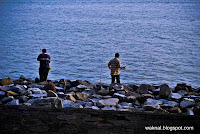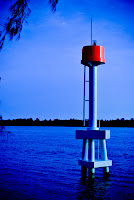



aperture value
The amount of light passing through the lens is controlled by the aperture hole. The aperture value indicates how much light can pass through. Since it is expressed as f/2.8, f/16, etc., it is also called the "f-number." The f/1 aperture value represent the maximum diameter of the aperture. When the aperture is half the size, it is called f/2, and when a quarter of the full size, it is f/4. The f-number is therefore the denominator of the fractional size.
The larger the denominator or f-number, the smaller the aperture size and the less light can pass through. Note that although f/2 is half the diameter of f/1, the total area of the hole is only one-fourth of the full-size hole (1/2 x 1/2 = 1/4). And so the amount of light passing through is only 1/4 that of the full-size hole. When the f-number is doubled, the amount of light shrinks to 1/4 of amount.
The larger the denominator or f-number, the smaller the aperture size and the less light can pass through. Note that although f/2 is half the diameter of f/1, the total area of the hole is only one-fourth of the full-size hole (1/2 x 1/2 = 1/4). And so the amount of light passing through is only 1/4 that of the full-size hole. When the f-number is doubled, the amount of light shrinks to 1/4 of amount.
shutter speed
The shutter controls the amount of time that the light can strike the imaging sensor. Along with the aperture that controls the amount of light, the shutter speed works in combination to control the total amount of light the imaging sensor receives.
With the same aperture, using a shutter speed of 1/2 sec. decreases the amount of light by half compared to a shutter speed of 1 sec. And a shutter speed of 1/4 sec. yields one-fourth the amount of light. Unlike the aperture, the difference in the shutter speed readily corresponds to the difference in the amount of light. The shutter speed is indicated by the denominator. For example, "500" means 1/500 sec. Since the sensor can record an image only while the shutter is open, it can freeze (with a fast shutter speed) or blur (with a slow shutter speed) a moving subject.
exposure
This is the amount of light received by the imaging sensor as determined by the aperture and shutter speed. The ISO speed is also a factor in the exposure so sometimes it is included as part of the exposure equation.
A "correct exposure" refers to an image which has about the same colors and brightness as seen by the human eye. It represents the correct combination of the shutter speed, aperture, and ISO speed. If the image looks too bright, it is overexposed. And if it looks too dark, it is underexposed. To obtain the correct brightness, the camera's shutter speed, aperture, and/or ISO speed is adjusted.
With the same aperture, using a shutter speed of 1/2 sec. decreases the amount of light by half compared to a shutter speed of 1 sec. And a shutter speed of 1/4 sec. yields one-fourth the amount of light. Unlike the aperture, the difference in the shutter speed readily corresponds to the difference in the amount of light. The shutter speed is indicated by the denominator. For example, "500" means 1/500 sec. Since the sensor can record an image only while the shutter is open, it can freeze (with a fast shutter speed) or blur (with a slow shutter speed) a moving subject.
exposure
This is the amount of light received by the imaging sensor as determined by the aperture and shutter speed. The ISO speed is also a factor in the exposure so sometimes it is included as part of the exposure equation.
A "correct exposure" refers to an image which has about the same colors and brightness as seen by the human eye. It represents the correct combination of the shutter speed, aperture, and ISO speed. If the image looks too bright, it is overexposed. And if it looks too dark, it is underexposed. To obtain the correct brightness, the camera's shutter speed, aperture, and/or ISO speed is adjusted.

No comments:
Post a Comment